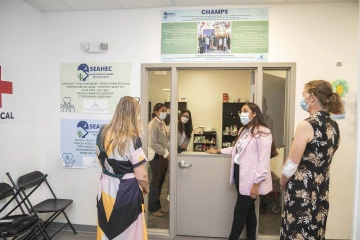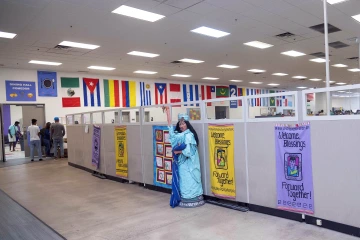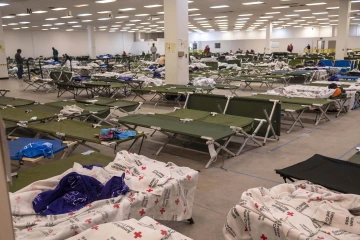Health Sciences faculty step in when migrants need help
Before the MILAGRO Collaborative became a course for students, UArizona faculty stood up to help the less fortunate.

An employee of Casa Alitas, a refuge in Tucson for migrants and asylum seekers, conducts an orientation session.
Not many people today can agree on solutions to the influx of asylum seekers at the United States’ southern border. But while politicians and pundits argue over what to do, several University of Arizona Health Sciences faculty members joined the Tucson community to provide aid to migrants looking for a better life.

Lisa Kiser (right), DNP, an assistant clinical professor in the UArizona College of Nursing and one of the faculty leaders of the program, and Susana Selig (in pink), associate director of Casa Alitas, speak with visiting scholar Angela Dawson of the University of Technology Sydney.
After going through processing, the U.S. Border Patrol and Immigration and Customs Enforcement agents often dropped migrants at Casa Alitas in Tucson. Casa Alitas provides a safe, temporary place for migrants to rest; get food and water; care for their children; and make arrangements to continue their travel within the U.S.
While the majority of services at Casa Alitas are provided by Catholic Community Services and volunteers from around Tucson, a small group of University of Arizona Health Sciences students, along with a committed, passionate faculty cohort, get a chance to see Casa Alitas’ transformative work up close through the MILAGRO Collaborative and the volunteer work they provide for the shelter.
What started as a group of faculty members volunteering individually to help with the influx of migrants eventually evolved into the MILAGRO Collaborative, a course for students across the Health Sciences. They are joined by students and faculty from the Arizona State University School of Social Work. All the students gain experiential learning while helping others.
Wanting to help
Bryna Koch, DrPH, an assistant research professor in the Department of Community, Environment & Policy in the UArizona Mel & Enid Zuckerman College of Public Health, started volunteering in 2014, when there was an increase in unaccompanied minors and families with young children crossing the border.
“Immigration officials, Border Patrol or Immigration and Customs Enforcement were bringing families to the Greyhound bus station, and they had very little support,” Koch said. “Catholic Community Services and others came together to try to see how they could meet the needs of these families.”

Lisa Kiser chats with Casey Harrington, a nurse practitioner, in an examination room at Casa Alitas.
Koch’s experience as a Peace Corps volunteer fostered her desire to help at Casa Alitas.
“I was the Sunday evening person who would help the migrants meet their needs and get them to the bus station,” Koch said. “For a long time, my role was waiting at the bus station to make sure people got on their buses because the buses run all night and getting them where they needed to go required a lot of logistics. I made sure they understood their tickets and how to make transfers on their trip, which is hard in another language.”
For Lisa Kiser, DNP, an assistant clinical professor in the UArizona College of Nursing and one of the faculty leaders of the program, the fall of 2018 was a tipping point.
“I’ll never forget. The number of people who were migrating just went up exponentially all at once. Normally, we would see maybe 10 to 15 people a week. All of a sudden, we were getting 100 people a day, which is something we had never seen before,” Kiser said. “So, the call went out to the community saying, ‘Please come in, we need you! We need people to come in and help with physical assessments, from the health care perspective.’
“Starting around October 2018, those of us who had been volunteering started to coordinate meetings as part of a humanitarian response to the increase in asylum seekers. We realized the value of bringing students into this. We wanted to be able to have an innovative, rapid-response model of education. It was clear this was an interprofessional collaborative effort and we didn’t want it to live in one of these colleges since it was faculty from four Health Sciences colleges (in Tucson).
“And from that start, we looked around and realized that a number of us in the university were all volunteering there and that several from the College of Medicine – Tucson had brought some of their students in to help. We decided it made sense to coordinate our efforts coming from the UArizona Health Sciences.
“We think it works because it’s not hierarchical. There is a deep respect that each of us have and a depth of experience, as do our students.”
A true group effort
Before retiring in 2018, Jill Guernsey de Zapien, who was program director, Health Promotion Sciences Department in the Zuckerman College of Public Health, was the associate dean for community programs. Because of her deep background, experience and relationships with communities along the U.S.-Mexico border, she was able to work with not only the university community, but outside groups, like the Kellogg Foundation, to put together programs around service learning. Guernsey de Zapien has since returned to the College of Public Health in a part-time role as director of border and binational programs.

The entrance to Casa Alitas is decorated with flags of the countries the migrants hailed from and includes a version of the Statue of Liberty, holding a baby.
When the organized volunteering at Casa Alitas began, one of the master’s students in the first cohort set up a database to track who was volunteering, Guernsey de Zapien said. Other students helped establish a system to distribute food and clothing.
“They were running around making all these good things happen,” she said.
“One of the things that kept bubbling to the surface was the response to this growing humanitarian crisis along the U.S.-Mexico border,” said Elizabeth Hall-Lipsy, JD, MPH, an associate professor in the R. Ken Coit College of Pharmacy and director of the PharmD Forward program. “The impacts of that migration effects our local communities, which weren’t equipped to handle the volume and quantity of people coming to the border.
“It was a phenomenal opportunity not only to address a need that was happening within our communities, but a way to bring students in to be part of a solution and to really give them the idea that as a health professional you can take the steps that will address a problem the way you think it needs to be addressed.”
Finding solutions, no matter how small
While the tide of migrants ebbs and flows from month to month and year to year, there is enough work to immerse the students in the assistance. Sometimes that help involves trying to communicate with people who aren’t Spanish speakers. Migrants have come from around the globe and speak Spanish, Portuguese, Ukrainian, Mandarin and indigenous languages.

Rows of cots fill a room for the arriving migrants to rest in.
Hall-Lipsy, who is the faculty advisor for the pharmacy students, said explaining medication instructions across multiple languages was a concern, but one student created a pictogram to show the migrants how and what to take rather than try to translate the information into every language. That sort of ingenuity and problem-solving on the spot can be critical for health care professionals.
“I think what happens is it shows them how they can approach their chosen profession through a public health lens” and create systems to solve problems, she said, adding that bridging those gaps can be significant. “Language access can shape access to health care and the quality of care you receive.”
“I think we’ve been incredibly fortunate to have a group of people who have come together to participate,” Hall-Lipsy said of the faculty and students. “To have people who are so committed to serving the migrants. We’re all working in academia and many of my colleagues are clinical professionals, so they have a practice and they teach and they continue to do this.
“Last year we were really lucky to be included in some of the experiential education initiatives from the Health Sciences and that provided so much needed foundation and support. I can look back and track the experiences that I had in public health school to where I am and what I am doing now. I think about the impact Jill had on me (when I earned my master’s) and the direction of my professional career. I can only hope that I have the same impact on these students.”

